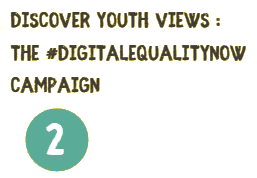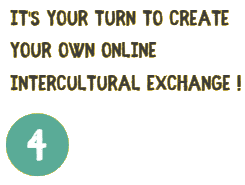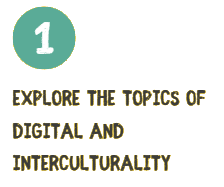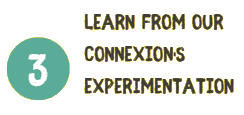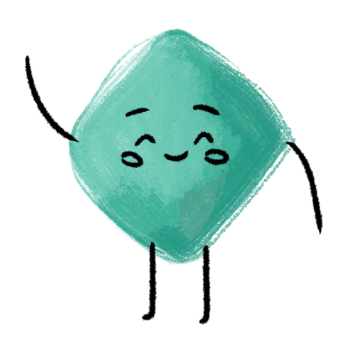Practical implementation of an online intercultural exchange
The experimentation of the Connexion·s project
At the end of our 2 years and a half project, after deeply exploring the concept and realities of interculturality and digital, the consortium experienced its own intercultural online activity : “You(TH) CREATE”. This hybrid intercultural meeting brought together 32 young people from the 4 partner countries (Belgium, Macedonia, Tunisia, France).
The aim of the meeting was to explore the themes of interculturality, digital technology and civic commitment. Through various workshops and discussions, participants discovered new tools and debated what these themes mean from different points of view and cultural perspectives. By meeting virtually, they began to work together to design a digital campaign addressing digital inequalities.
Examples of activities we have tested during the online sessions:
Start playing
Jeu de la lettre (Intercultural game (in French)
Number of participants: Min: 2
Maximum suggested: 20
Time: 30 min – 1h
The “jeu de la lettre” is a very great and easy game to understand what is “cultural perception”. This activity helps to raise awareness, before departure, of the fact that our feelings are guided by our experience and culture, and that if we don’t go beyond these feelings, we may miss out on reality and the discovery of others.
Feedback: The youth liked it a lot, and we created a debate after on cultural lens and how to understand someone else when there is no “right or wrong” but only difference of point of view.
We would recommend using the “cultural iceberg” (easy to find on the internet) or deeper discussions.
Jeu de l’exception (CF CCFD) + debate on the notion of belonging, identity, etc. in French
Number de participant·e·s: Min: 9
Maximum suggested: Undefined
Time: 20 min – 45 min (Depending on the number of participants)
The game of the exception explores the notion of group and rejection. The aim is to talk about what it feels like to find ‘your own kind’ and to be isolated. It’s an entry point for discussing exclusion and thinking about people who find themselves in situations of rejection and discrimination in our societies and the world.
Benefice and inconvenient of digital
Duration : 1h – (5 minutes: all participants log in – 10 minutes: link sent – rules explained and tool appropriated – 30 minutes: moving debate – 15 minutes: debriefing)
Number of participants : 25 people maximum on the free version
Number of facilitators : 1 minimum
This game simulates scenarios where participants have to defend their point of view on concrete situations involving the use of digital technologies. Participants move around Gather Town to indicate their position (agree/disagree) on each statement. Small-group or plenary discussions follow each move to explore the arguments on each side. After the debate, a feedback session allows participants to share their feelings and analyze the different positions expressed.
Feedback : Gathertown worked pretty well because of the guidance and the fact that we tried it before with our colleagues. Since we tried it before with people that never “played” it, it was easier to see what could not work and what was not obvious.
Brainstorming session of introduction of international solidarity and discussion
Number de participant·e·s: Min: 15
Maximum suggested: Undefined
Time: 20 min – 45 min (Depending on the number of participants)
The aim of this brainstorming session for solidarity was to foster a collaborative environment where participants can generate and share ideas that promote unity, mutual support, and collective action.
This session’s goal was to familiarize the participants with the solidarity and its meaning and on the other side to create a safe space where participants feel comfortable sharing their thoughts and experiences, which can help build trust and understanding.
More info from the session and participation of youth on the link below
Feedback : The participants enjoyed being able to share their opinions on the questions, and for those with less experience, it was very instructive. However, it was difficult to make sure that everyone participated on Padlet, and the interaction during the discussions lacked structure. There should also have been more time to allow everyone to get fully involved.
Inter Knowledge – Hunt
Number de participant·e·s: Min: 15
Maximum suggested: 25
Time: 20 min – 45 min (Depending on the number of participants)
The game serves as an icebreaker, helping participants feel more comfortable and engaged. By finding and sharing items from their environment, participants can break the initial ice and start interacting in a fun and relaxed manner. It also provides a structured way for participants to introduce themselves.
Feedback : The participants had fun getting to know the other participants, and everyone presented themselves in an original and interesting way. However, this activity requires a stable internet connection, and it would be important for participants to turn on their cameras during the presentations.
Inequalities of access to digital
Number de participant·e·s: Min: 15
Maximum suggested: 35
Time: 45 min – 60 min (Depending on the number of participants)
The game “Inequalities of Access to Digital” aims to highlight and explore the disparities in access to digital technologies among different groups. Participants are given tasks to find items around their environment within a set time (e.g., 2 minutes). They then share these items via webcam, introduce themselves, and discuss how they feel using emoji reactions. This activity encourages participants to reflect on their own access to digital tools and share their experiences, fostering awareness and understanding of digital inequalities.
Feedback : The participants were able to learn about the concept of international solidarity through the presentation and reflect on their own situation. However, this activity requires a stable internet connection, and participants need to be informed in advance in order to answer questions relating to their actual situation.
Intercultural game
Number de participant·e·s: Min: 8 (but max. 8/group)
Maximum suggested: Undefined
Time: 30 min – 60 min (Depending on the number of participants)
The intercultural game is designed to launch a discussion between participants on their cultural perceptions associated with countries and what we know about others. This enables stereotypes to be identified and then discussions that take place between participants helps to deconstruct these stereotypes and learn from them.
Feedback: The young people appreciated having time to discuss their stereotypes and representations of other countries. Dividing them into small groups allowed everyone to have their say. However, dividing the groups took time because the leader did not have the authorization to do on the Zoom application, but a partner quickly took over. There was also a lack of time for more in-depth discussions, and you have to be prepared for the unexpected.
THE CIRCLE GAME
Number de participant·e·s: Min: 12
Maximum suggested: 25
Time: 50 min – 1h15 (Depending on the number of participants)
The circle game explores the feeling of being rejected from a group, both from the point of view of the person who is excluded and from the ones who are excluding (what emotions do they feel ?). It’s a way of approaching the theme of culture shock and interculturality through a discussion to improve our capacity of empathy.
Feedback: The discussions on intercultural shock and the feeling of exclusion allowed a sincere exchange between the participants, all of them having already experienced some form of exclusion. This strengthened the cohesion of the group and encouraged reflection on the different ways of perceiving and integrating others. However, the group was too small (3 people), which prevented a real group effect. The excluded person was more of an observer, without feeling rejected. It would be preferable to have at least 12 participants and to define more precise roles to better convey the feeling of exclusion.
Role-play: intercultural encounters
Number de participant·e·s: Min: 12
Maximum suggested: 25
Time: 8 to 12 minutes for the main part. Additional time depends on the discussion that follows, where the groups share their experiences and answer debriefing questions, such as their feelings and observations during the game.
The following role-play is an excellent way to raise your participant’s awareness of the importance of differences in non-verbal communication. It may even help students to experience culture shock for a few minutes. Therefore, it is probably best used with a monolingual/monocultural group who has little or no experience of meeting people from other cultures.
Our testimony and tips following this experimentation
V Intercultural aspects, small-group exchanges, acquisition of communication skills
V Discovery of tools like Gather town, hybrid participation enabled young people from various countries to exchange ideas despite visa or economic constraints
V English subtitles facilitated understanding, and partners coordinated well via dedicated channels to resolve logistical problems.
X Camera problems and unknown names, making harder the speech management
X Oral instructions sometimes lacked clarity, and the uneven internet connection disrupted activities.
→ Improve planning, avoid sessions that are too long
→ Test digital tools in advance
→ Favor more relaxed moments of exchange adapted to the objectives.
